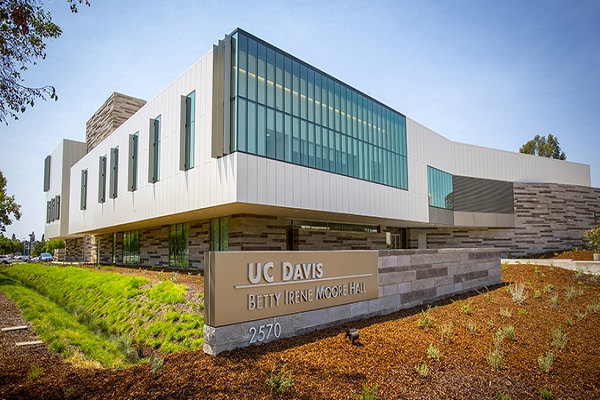University of California, Davis: A Tree Reborn, a Commitment Renewed
Where others today may see only trees and water, Patwin Elder Edward “Bill” Wright envisioned his ancestors hundreds of years ago living on the banks of Putah Creek where UC Davis would eventually be built.
“It was one of his favorite spots,” said Juan Ávila Hernandez, a member of the Committee to Honor the Patwin and Native Americans, referring to a small clearing along the creek’s historic channel (today it is the Arboretum Waterway).
Elder Wright, who died last September at the age of 84, and other committee members particularly liked the site for the decades-old live oak and California buckeye trees that provided a massive canopy to filter the light and create a relatively secluded space underneath.
And so it would become the Native American Contemplative Garden, chosen by the committee of representatives of the Patwin community, and UC Davis faculty, staff and students, and dedicated in November 2009.
Twelve years later, the nearly 40-foot-tall buckeye broke apart, leaving a 10-foot-tall stump, about 4 feet in diameter, hollow, as it turned out. The buckeye was among the first trees to be planted in the Arboretum 85 years ago, records show.
Ávila Hernandez was among the first to take notice of the fallen buckeye, around the end of 2021, setting in motion a replacement project that culminated in a tree-planting ceremony March 4. Three saplings will vie to be the buckeye that takes over the spot overlooking the Native American Contemplative Garden.
Elder tree
The older buckeye’s stump is several feet away, after Arboretum managers and the committee decided to leave it along with some of the large limbs that crashed around it. Read more about this natural sculpture.
Assistant Vice Chancellor Kathleen Socolofsky, director of the Arboretum and Public Garden, who led the tree-planting ceremony, noted the green shoots coming out of the trunk: “It is still living. It will be the elder looking after the next generation.”
She spoke to 30 or so people who had gathered around the Native American Contemplative Garden’s centerpiece: a basalt column inscribed with the names of 51 Patwin men, women and children removed from the land by Spanish soldiers and missionaries and taken to missions from 1817 to 1836.
Other basalt columns — telling other parts of Patwin history — line the garden’s path, which meanders like a creek. The path leads to a seating wall that is coiled in the way a Patwin would start to weave a basket.
History professor Ari Kelman, faculty advisor to the chancellor and provost, also addressed the gathering. “This garden points in two directions,” he said. “It provides space for native and non-Native American people to consider the past, and it presents the possibility of creating a better future together.”
Collaboration continues
Renetta Garrison Tull, vice chancellor of Diversity, Education and Inclusion, thanked the Committee to Honor the Patwin and Native Americans “for making this garden possible and bringing us back here today to honor the spirit of this beautiful buckeye tree.”
The committee was established in 2000 after excavation work for the Mondavi Center for the Performing Arts revealed the remains of 13 Patwin.
Tull reaffirmed the commitment of the chancellor’s office to acknowledge the Patwin as the first people on the land. She said she looked forward to the committee’s continued work with members of the Native community “to help guide the way UC Davis honors Native Americans into the future.”
Inés Hernández-Ávila, professor in the Department of Native American Studies, among committee members past and present who attended the ceremony, said she appreciated that the tree-planting represented a renewal of the university’s commitment to the committee’s work.
Speaking from her Native perspective, she emphasized “the need for us to be recognized as the original inhabitants of the land.”
Kelman, speaking on behalf of Chancellor Gary S. May and Provost and Executive Vice Chancellor Mary Croughan, who could not attend due to other commitments, commended the committee for its “essential work” over two decades. Besides overseeing the garden project, the committee guided the installation of a monument outside the Mondavi Center in 2019. More installations are planned around the campus.
Hernández-Ávila described it as “a work of spirit, a work of the heart.” Her husband, Juan, added: “If we choose to sweep that history under the rug, choose to forget about it and don’t put it into the curriculum, then we are in danger of losing our humanity. And that would be a dire state.”

